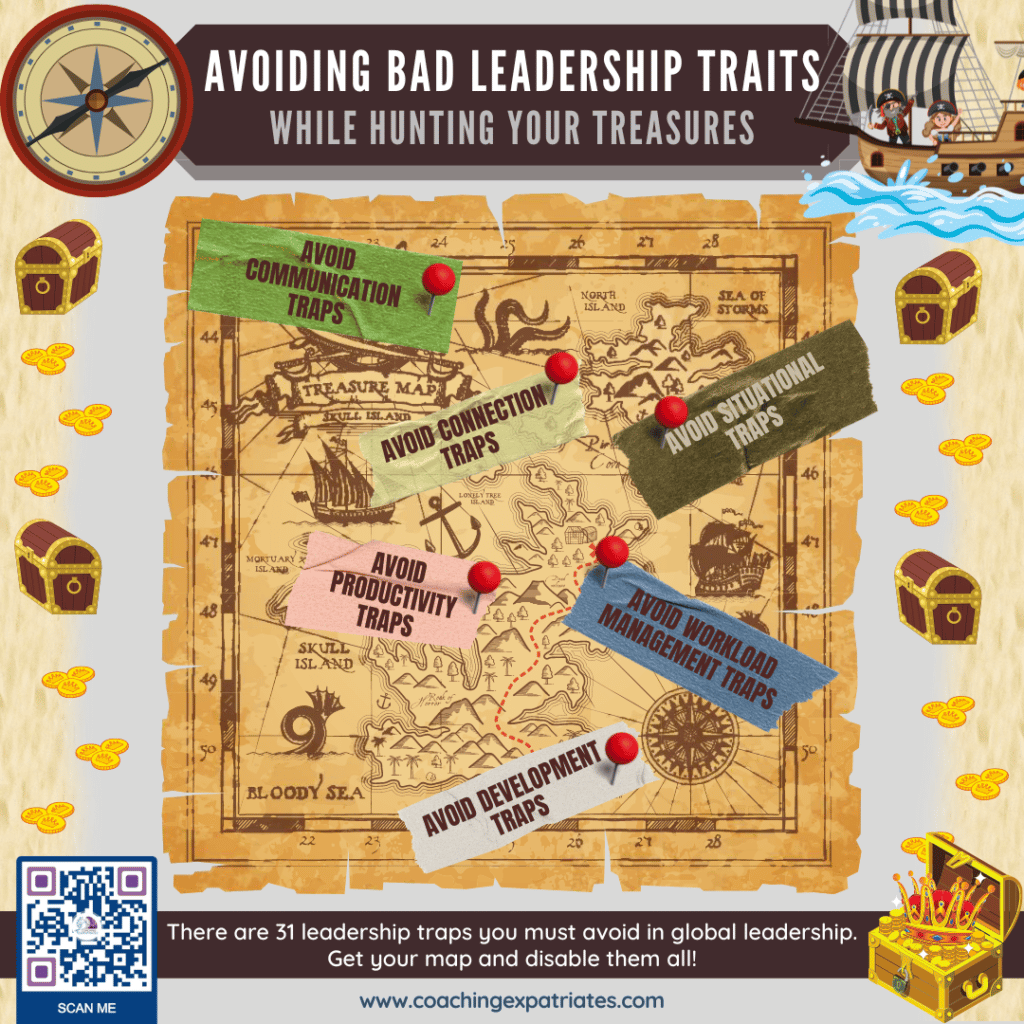If you are a growing leader in an international corporate environment, you know the importance of nailing global leadership in all 4 pillars of success, while avoiding bad leadership traits that can create roadblocks to your career and reputation. In a global and multicultural work environment, we have to be extra careful in the effort of being a fantastic global leader.
In this article, we will cover why avoiding bad leadership traits is so important, what are the 31 key bad leadership traits you should avoid, and how to build an effective evaluation system to track your own performance in avoiding these key elements to achieve greater excellence in your leadership.

Before we begin, though, let me tell you about my secret Boss Ranking System. Well, not so secret now anymore.
The Boss Ranking System: Leadership Traits Mapping
During my couple of decades working for multinational corporations, I had many types of bosses. Good bosses, bad bosses, and so-so bosses. A few of them were exceptional. I used to silently rank them from Exceptional to Very Bad on a 5-point scale. Exceptional, Good, So-so, Bad, and Very Bad (aka awful!).
Why would I do that if I didn’t share the results with them or nobody else?
Because this forced me to reflect on their good points, bad points, and what I wanted to take as lessons learned from my experience of being led by them. By doing so, I was exercising something that I call “Progress Orientation.” I was focused on making progress as a leader by learning from my experiences.
When we force ourselves to reflect like this, we gain tremendous self-awareness and start developing ourselves towards something better.
Below I will share with you traits that I looked for in each boss to help me identify and define how to evaluate and rank them in my list. We all have performance appraisals made by our bosses, right? Even if they don’t know it, why shouldn’t we also appraise them to learn in this process?
I’m sure this sounds exciting enough, but I’d like to explain, from my perspective, why I think it is so important to avoid these bad leadership traits, in the first place. Read this article right after, if you want to deep-dive into the difference between a global leader and a manager, and what is expected from each of them.
Why Is It So Important To Avoid These Bad Leadership Traits?
If you want a good reason why you should avoid displaying certain bad leadership traits, I will give you solid 10 reasons why. Let’s review them one by one.
1) Hurts Potential Talented People
Some of the things you do and say will impact your employee’s morale and performance. These actions might even hurt a person’s mental health, mind you. Some of these employees may be or may become top talents in the company and may become even important leaders in the industry. They might even become your next employer.
The world turns, my friends. You might be hurting someone who you will need in the future. I don’t think you should avoid anything out of fear, though. Make sure to avoid bad leadership traits because you want to be a good boss and help develop good talents.
2) Hurts Team Performance
A bad leadership trait might happen with one person or with an entire team. Whatever the case, it will hurt the team’s performance. Whenever you throw off one person on the team, the entire team gets affected. You should also consider that whenever something happens with one person on the team, the rest of the team will perceive this as potentially being able to happen to them as well. You instill fear and distrust in the team, and you don’t want that.
3) Hurts Your Reputation
People talk. It’s a misconception to think that your own employees won’t evaluate you. People talk more than ever with today’s internet and worldwide connection capabilities (either through LinkedIn, Glassdoor, or other informal connections) the same way you call for referrals. If you display a few of these bad leadership traits on a consistent basis, people will talk about it, and it will become part of your reputation.
4) Hurts Company’s Bottom Line
If you think your actions can’t really hurt a big company’s financials, think again. Whenever you misstep as a leader, you will end up hurting the company’s bottom line, one way or the other. If you do things that hurt employees’ morale or affect the team’s performance, you hurt the company’s financials because you are paying the same for less effective people. Also, bad leadership traits can have ripple effects in other areas of the company, affect a project’s progress or success altogether, and even a relationship with customers that can develop into lawsuits or worse.
5) Hurts Working Relationships
Piggybacking on reputation, I saw many executives lose solid working relationships because they were pricks with their employees and were “found out.” I personally know of a man who would always pay fewer bonuses to his female employees. He’s done that for years, and this never affected his working relationships. Until one female decided to make a huge fuss on the matter. It turned into a lawsuit he lost, and everybody around him felt the implicit need to ostracize him to show that they were “not the same.” This man not only lost his working relationships and, eventually, his job, but his bad reputation prevented him from getting a new equivalent job, and no connection he had ever helped him again. At least from what I know.
You see, you might think you are getting away with certain things you do and say. But things change, and you should not assume that something you’ve been doing or how you’ve been acting won’t ever hurt you back. After all, what goes around….
Quite frankly, working relationships is the best asset you build during your stay with any company. Not the money you make, not your title, not your corner office. Your working relationships are precious, and taking good care of them will yield dividends throughout your working life.
6) Hurts Company’s Culture
If you have pets and kids, you know this to be true: what you do and say, and how you do and say, dictates how things are done and said in that environment. We are humans, and it’s natural to look to the leader – be they formal or informal – when we are doing things. We mimic and replicate those in authority positions or those that we admire and care for.
This means culture starts from the top to the bottom and cascades down until the entire organization is taken over. That does not only happen in corporate culture. It can happen in any culture. The school, the church, the study group, the campers, and so on. So long as 2 or more people are grouped together, a culture will be formed. If you show bad leadership traits from the outset, you are dooming that culture for sure.
7) Hurts Your Health
This is less obvious, but in truth, whenever you start acting like a jerk, knowingly or unknowingly, you set in motion ripple effects that will create situations that will increase the level of stress for you and the environment you are set in. Stress can be insidious, and when you feel its true effects, you are already very late in the game to make the right corrections to prevent long-lasting issues. That’s why avoiding bad leadership traits in the first place is the best remedy.
8) Hurts Your Pocket
This goes without saying, but if you affect team performance and the company’s bottom lines, this will end up affecting your own pockets as well. I can think of at least 2 ways this can happen, but if we would brainstorm together, I’m sure we could come up with even more.
The first one, and more obvious, is fewer bonuses, rewards, and other types of compensation due to poor performance. You could even be demoted and earn less in some countries and regions. Or worse, you can be fired altogether!
The second one is the liability that bad leadership traits can generate for you and the company. During my early career, I had such a suffocating boss that I ended up creating an excuse to resign and look for work in another division, just to get away from that awful person. I learned later that this person was sued by another employee, was fired, and, eventually, even ended up in jail. Sounds extreme? Well, this is a true story, and I am pretty sure you will hear about many more out there, if you start asking.
9) Hurts Team Stability
Not every company has employee turnover as one of the performance metrics of the leader, but many do. When I worked for the now extinct GE Corporate Audit Staff, every 3 months or so, an HR business partner would talk to each employee in an audit team to evaluate their audit manager. Then, in the end, they asked a simple question: “would you ever work with this person again? Yes or no?” Interestingly, by making you take a stand, you were not directly saying you had a bad or good boss, but you were showing clear signs if you liked working with that person or not.
As a personal practice, whenever I went to interview for a new job, I would always ask HR, at the end of the interview, what was the average number of years employees would work for this “boss-to-be.” The answer was always a great indication of that person’s reputation, based on the answer itself, and how HR would answer it. That’s why, by the way, as a hiring manager you should always get prepared for the interview: because you’ll get some though questions like this.
If a team’s turnover is too high, there is something wrong. It might be due to several reasons, of course, not only how good the boss is, but it’s an important red flag. People often say they don’t leave companies; they leave bosses. Although that is not always true, it happens a lot. I once had a great boss. She was really a great person, and I liked her. But she was an awful workload manager. She would overwork hard-working people and throw things under the carpet when it came to slackers.
10) Hurts Trust-Building Efforts
We are humans, and we all make mistakes. In global leadership, more so is due to the multicultural nature of the relationships and challenges. Depending on your personality and your personal values, you might give a person a second chance. Or not. That’s all good and fine until the leader starts misstepping over and over again. No one survives repetitive trust breaks. People will irrevocably lose trust in you at some point, and your reputation will dip. Trust is so hard to earn, so you don’t want to lose it that easily.
31 Bad Leadership Traits You Must Avoid As A Global Leader:
Now that you unveiled the 10 main reasons why you want to avoid bad leadership traits, let’s explore what they are. I will split the 31 traits into main 6 categories that I will call here as “traps.”
🐭 Situational Traps
➡️ Avoiding conflict and placing issues “under the carpet” instead discussing and sorting them out. Who likes conflict, right? We have enough dramas in our families, our friends, and God knows where else. We don’t want more things to dwell upon. That’s reasonable. But throwing things under the carpet to avoid discussion and conflict is not the solution. On top of that, it hinders trust building and even reputation. Wants a good read? Check Crucial Confrontations; a must-read book if you want to improve on the matter.
➡️ Making assumptions instead of always clarifying everyone’s understanding. It’s very common to have most leaders get a hit on this marker. That’s natural. We all make assumptions. Our employees will also make assumptions. That’s why we have to always check understand. Our understanding and theirs. “I will recap my understanding of what you just said. Tell me if I missed the mark here.” When you open the lines of communication like this, you are implicitly giving permission for the other person to correct you. You are sending a hidden message that “it’s ok to correct me now.” The other way around also works: you can ask, “can you recap for me what you understood from what I am asking of you? This will help me check if I forgot to say something important.” This way, you are opening the lines of communication and saying that if the boss is correcting the employee is because of the boss’ lacking, and this eases people’s minds as well.
➡️ “Throwing employees under the bus” to avoid blame. This topic is both a deal breaker and a trust breaker for most employees. If you, as the boss, do this, it will likely be over for you and your reputation. You might think you can kite blame if you throw someone else under the bus, but it will actually be temporary. People talk. In the long run, your reputation will be hurt. If you feel tempted to blame someone else, remember that taking responsibility is not assuming the blame. It’s embracing the reigns of the correction. Don’t focus on the blame. Focus on the solution.
➡️ Allowing unconscious biases to dictate decisions. We all have biases, and we all have a huge amount of unconscious biases that cloud our judgment on a daily basis. If you don’t know what unconscious or implicit bias is, it’s time to get yourself educated on the topic. Unconscious biases deprive us of making good and honorable decisions. That’s why you must learn your unconscious biases and start working on them.
➡️ Not knowing to “read the corporate gameboard.” In other words, not knowing what’s happening in the corporate network backstage. Admittedly, you get better on this the more experienced you get. Experienced not only in terms of the number of years of work experience you have, but also in the number of years you are with a company and industry in particular. Organizational leadership tools that help you improve your business acumen and executive presence are fundamental to achieving this. Subscribe to our First 90-Days Guide As a Global Leader. It will help you get started in acquiring this business acumen and executive presence when in a new position.
➡️ Taking credit for other people’s ideas and work. It’s not uncommon to see certain people take credit for other people’s work when they are in leading positions. If your team or someone in your team did something spectacular, make sure to name them and give them due credit. If you are their manager, you’ll naturally be praised for being their manager. If you are part of that person’s team, you will also be praised for your integrity in giving credit to whom it’s due.
➡️ Forgetting that we should lead by example, not by words. Oh gosh, how many times have we heard about leading by example? Are you fed up already? You might be, but you shouldn’t. And that’s because whenever we are out of our comfort zone, we resort to words instead of action when leading. It’s easy to lead by example when we feel good in our own skin, but it’s really hard when we are challenged or facing uncertain times. And nowadays, when are we NOT facing challenges and uncertain times as leaders? Right? That’s why I am reminding you again here. Make your best effort to lead by example. Your actions will define group habits and culture more than your words.
➡️ Being stubborn and unwilling to change when needed. Some changes are obvious, and some changes are less so. That’s why being open to new perspectives couples splendidly well with this topic. If you cannot see the need (and importance of) a change enough to make it, surround yourself with people that can give you their insights about the topic. If you see something that needs to change, make it happen with their help. Don’t procrastinate on the matter just because you don’t know what to do, how to do it, or won’t like the process. This also relates to “throwing things under the carpet.”
🐭 Communication Traps
➡️ Setting unrealistic expectations instead of managing them. This sounds vague, but when you have a boss that does this, you know how hard this can hit. As the boss and the leader, you must realize that employees might often not voice their concerns about the unrealistic goals you set. In some cultures, especially, they will never ever voice them. The less confrontational a culture is, the less they will voice their concern about this. This means you have to be very watchful to manage expectations instead of simply setting them the way you want.
➡️ Not knowing how to “read the room” and understand non-verbal cues. Some people are naturally talented at reading people’s body language. Dogs, for one, are experts on this. Do you know why? They cannot communicate in the same language you do, so they observe you very attentively. They figure you out by learning your body language and regular patterns. This will sound very strange, but you have to do like dogs: talk less and observe more to find people’s patterns and body language cues.
➡️ Not knowing how to communicate with high and low-context cultures. This is a fascinating and complex topic that every global leader on the planet must learn about. In a previous item, we were talking about patterns, right? Well, some experts figure this out for you and identify that some cultures have some types of patterns and others view things differently. To simplify our world, they categorized these patterns into a model to help you quickly assess a situation and find the best course of action to communicate effectively. Sounds intriguing enough? It quite is. Go read my article on that to get yourself started.
➡️ Displaying poor multicultural competence. Another one of my favorite topics, cultural competence, is a fascinating and complex topic. When you interact with people, it can be easier or more difficult depending on how different their cultures are from yours. That’s why I say it’s so easy to misunderstand people and situations in global settings. And that’s why I say it’s so important to learn more about it: opening up your mind makes you less tempted to jump the gun and allow a misunderstanding to happen.
🐭 Connection Traps
➡️ Not knowing and adjusting to your employees’ needs and preferences. Why do YOU have to adjust to them, and not the other way around, you ask? Trust me; they are already doing everything in their power to be on your good side. Do your part and learn what their needs and preferences are as well. Then act on it. It will not kill you to ask, “what do you need?” in critical moments, and pull some strings to help them.
➡️ Not knowing your team members’ values, desires, and motivators. If you get to know what they want, why, and how, your chances of leading them effortlessly increase. It’s that easy; why not do it? Make an effort to map each team member’s core-values, motivators, and goals or desires.
➡️ Not helping your employees develop critical thinking for fear of disobedience. I know there is a huge generation clash between oldies who think the younger folks can’t think straight and have no critical thinking. And young folks who think their bosses are old farts who do not know “the world has changed.” Let’s not talk about the clash here for a minute. Let’s talk about the opportunity. People from different generations have different perspectives and different experiences. If both sides are open to new perspectives and willing to make adequate changes, they, too, can go from storming to performing, like any team. Where there is a will, there is a way. It’s true that older and experienced folks can help younger generations improve critical thinking, but, at the same time, it’s true that younger generations try new things and achieve new big ideas.
➡️ Failing to support and help your team members to learn and grow. It is sad that I see executives chaining good employees to their positions because they are afraid to backfill and retrain. I truly know how hard it is to be caught in this situation, both from the boss’s and the employee’s perspectives. As the boss, it’s crucial to let your talent go forward in their growth journey. Don’t chain them based on what you need. Think about their growth instead. Remember we talked about working connections being your most valuable asset you create while working for a company? Just because someone is not working for you anymore does not mean this connection is over. On the contrary. Look at things through this set of lenses. Allow and help your employees grow.
➡️ Breaking promises not followed by explanations and apologies. Breaking promises is bad already, but it happens. Sometimes we are certain we can make something happen. And then something huge comes our way, and we must break our promise. The rule of tump is not to make promises you cannot keep. But in the event of making a promise that you have to break, man up (or woman up) and come clean and explain the situation with the best of your abilities with a sincere apology. That’s it. If the person forgives you or not, it’s up to them, but you should do your part and come clean. Yes, especially if you are the boss.
➡️ Betraying people’s trust. That’s for sure the deal breaker for many people, pets, animals, ghosts, you name it, who else. Let me tell you a little secret. If you break the trust of someone you really love and care about, it will break your heart. If you are not a psychopath, it will break your heart, I’m telling you. Now, if you break the trust of someone you don’t know well yet or don’t care much about, you will feel sorry, but it won’t devastate you. That’s why when building trust —if you want to do it right — you have to have the right intentions and create authentic connections. Empathize with people while getting to know them. Otherwise, their trust in you won’t hold too much value to break your heart. If it does, you will go above and beyond not to break their trust. That’s why getting to know your employees’ values, preferences, motivators, and so on can be so powerful.
🐭 Workload Management Traps
➡️ Allowing hard-workers to overwork and slackers to stall work. In other words, poor workforce or workload management. Yes, I know slackers are such a headache, right? It’s so much easier to put the work on the desk of those you trust. But don’t fall into this trap. The game will be over for you at some point in the long run due to your best employees becoming burned out. Instead, sort things out and make sure everyone gets their fair share of work. If needed, fire the appropriate people or place them into a performance program.
➡️ Overworking your high-achievers just because they deliver more and better. A spin-off from the last one; every team always has the team’s star. That person who is the top talent, the high achiever. You might want to give them the work to provide them with the growth opportunity, but you might unconsciously also be sending things their way because you know it will get done. Well done, by the way. You can even feel the bonus in your pocket if they get the assignment. So check in with yourself about the real reasons you are giving people assignments. Even if you see it’s an opportunity reason, you are still not off the hook about workload management. Always double-check if the workload is appropriate. Even if they say, “it’s ok.” High achievers tend not to say “no” to a good opportunity. Ever. So check their workloads and don’t even make the offer if they are already swamped.
➡️ Micromanaging experienced people and macromanaging beginners. Newbie bosses and managers usually fall prey to this matter. Why? Because it’s easier to micromanage experienced people than micromanage beginners. Managing experienced people is such a breeze! It’s easy and fun! Now, try doing the same with beginners! It can be a nightmare, because you have to spend hours teaching them, doing with them, explaining, reviewing and so on. If you (as the boss) don’t quite know yourself what they have to do, then, oh, forget it! It’s even worse! But you are the leader. You are being paid to do your job, not to take the easy way out. And your job is to help and assist the beginners closely while giving some space and opportunities to those more experienced. Not the opposite.
🐭 Development Traps
➡️ Being financially illiterate. Not knowing organizational leadership and just relying on your gut when doing stuff is the worst way to go in global corporations. Shareholders want results and stock prices to go up. They don’t care about our guts. If we work on things and ideas without knowing their exact financial impact, this is a shoot in the foot. That’s why becoming literate in finance basics is imperative.
➡️ Feeding pride and vainglory (for yourself and your team’s). It’s good to feel good when we are full of pride. It’s natural to want to boast and brag. But feeding pride and vainglory also creates a lot of pressure and behaviors you’d want to avoid in your team. Those who are full of pride may do anything to save face as well. I already saw awful cover-ups just to save high executives’ faces. Not good. Bad for corporate culture. Even worse for employee retention. Focus on celebrating achievements instead of feeding pride.
➡️ Focusing on self rather than on the team’s success. Very often, when teams accomplish a successful project, the team leader or boss gets the reward. How about this: next time you are to receive a President’s Award or another type of award or prize, select someone in your team to get it on behalf of the entire team! Or coordinate something like this with your HR. It will be exciting for all of them, and they will genuinely appreciate you. Leading people goes beyond leading them to accomplish things you must also consider their morale and feelings.
➡️ Not focusing on creating an inclusive and positive corporate culture. Another of my favorite topics, not because it’s complex, but because it’s rewarding. A few years ago, I did several social experiments to better understand cultural formation. It’s a fascinating topic. When 2 or more people gather together for regular and continuous interactions, a culture is formed. How the leader, formal or informal, dictates these interactions from the start can sway the cultural formation one way or the other. Nasty or pleasant. It all depends on the leader and how they set things in motion. How fascinating is that? Same people, different scenarios depending on the spark. Make sure to give the right spark, then!
➡️ Not working on all skills of the 4 success pillars of global leadership. It’s gone the days when you had to know people’s leadership skills alone to be a good leader. Now, that’s only a piece of the equation. Global Leadership is based on 4 success pillars, if you want to do it right: personal leadership, people leadership, organizational leadership, and cultural leadership. You need all 4 to lead multicultural teams and/or international corporations.
🐭 Productivity Traps
➡️ Failing to delegate when needed and being too hands-off when not appropriate. This is piggybacking on the workload management topic. New managers often do this a lot too. They usually horde on tasks that they know how to do, and become hands-off on things they don’t know much about. Knowing when to delegate and how to delegate efficiently is a must for any leadership level.
➡️ Being surrounded by and paying too much attention to flatterers. Who does not like compliments, right? The more power you get in a company, the more flatterers will surround you. But research has shown that high executives that keep flatterers around them are short-lived. It’s always important to have people who speak truth to power around you. As a global leader, it’s crucial to see new perspectives and explore different avenues of action.
➡️ Inability to plan and prepare with a strategic mindset. Do you like to “swing it”? “Go with the flow?” Or do you really like to improvise? Studies show that more than half of the people who report enjoying improvising, actually say so because they do not know the best course of action to take on the topic at hand. And not because they like the lack of planning. Whatever the case, when you plan things ahead, you are engaging your brainpower to consider the best set of actions to achieve a goal. When the time comes to execute these actions, you leave brainpower to execution and won’t have to waste it figuring out what to do. Kudos to the planners.
➡️ Not being open to other perspectives. We can call this being prey to confirmation bias. It’s so much easier to find people and ideas that are aligned with what you think and want. Or finding theories and resources that prove you right about something. This is called confirmation bias and is often an unconscious bias. We talked a bit about it already, but I want to spell this type of bias out separately because it can happen very often in times of uncertainty and ambiguity.
➡️ Not having good personal leadership and overworking instead. Personal leadership is one of the 4 success pillars of global leadership. Unfortunately, it’s a pillar that many professionals overlook. The truth is: your consistent high performance is tight with how well you manage your personal leadership. Personal leadership leads self. You cannot lead other people well if you don’t start with yourself first and how well you lead your life.

Wow, that’s a lot! I know! And I am sure that while you were reading these traits, images of past experiences showed up as cutscenes in a movie. We all had some or all of these things happening to us before.
The truth is, no boss can be perfect. But if your boss is displaying 3 or more of these traits frequently, would you rate them Good, Bad, or So-So? What if they display 5 of them? What if they displayed 10 of these? How many of these would they have to avoid effectively for you to say they are “Good?” Think about this for a second.
I had a boss once who broke my trust. There was no going back with that person. I had to leave. For me, “betraying people’s trust” had a bigger weight than “Being stubborn and unwilling to change when needed.” You have to find for yourself which of these topics weigh more or less on you. Go over this list of traits and define each topic’s weight. Start with “deal breakers.” For example, ask, “if this topic happened to me, would this be a deal breaker for me in that job?”
Now, assessing your boss is all good and well, but you should consider using this list to develop yourself, not to badmouth your boss. Quite frankly, you will never be able to change a boss unless they see the need and want it.
Instead of focusing on what you cannot do, focus on what you can do. So, think of YOU as THE boss. What do YOU have to change in yourself or your mindset, to make sure you avoid all these things going forward to be considered “Good” in your ranking or tracking system?
Not exactly sure? If you want to be an international leader that avoids these bad leadership traits, hire me as your executive and leadership coach. We can map out together which traits you need to improve and figure out a plan to close gaps. We will work as accountability partners during the execution of your plan to quickly help you become an exemplary leader.
Meanwhile, use my suggestion below to get started.
How To Create Your Own Bad Leadership Traits Tracker
You can always use your gut feeling to tell if a boss is exceptionally good or terribly awful, right? But if you do so, people will quickly dismiss what you are saying, as they will think you are being vague and maybe even unfair. The same goes if you are self-assessing.
What if you quantify things?
Well, let’s do that right now.
Step 1: Reading Your List
Get an excel spreadsheet or google sheets and place all 31 traits above in a column.
Step 2: Preparing The Table
Create 3 additional columns. One that you will call “Presence” to define if that trait is present or not. The second will be “Frequency,” where you will tell how frequently that trait was displayed in the assessing period. I usually split frequency between “rare,” “sometimes,” and “consistent.” The third and last column can be called “Weight,” where you will put weight for that trait. You want to differentiate the traits that harm you more or less. I usually split this between “regular,” “High,” and “Deal Breaker!”
Deal breakers, for me, as the name said, are deal breakers. These marks are a huge red flag for me if they happen consistently. For example, breaking trust is a deal breaker for me. If I do this to someone, or vice-versa, the relationship will break, besides potentially causing other problems, as we mentioned in a previous section. Deal breakers, therefore, weigh a lot more in my assessments.
Step 3: Attributing Your Assessment
For each of these columns, you will attribute numbers for each definition. For example, in column 1 where you have presence, I usually use a binary definition like zero and 1. If present, I attribute 1, if not present, then it’s zero.
For the second column, “Frequency,” I usually attribute 1, 3, and 5 respectively for “rare,” “sometimes,” and “consistent.”
For the third column, “Weigh,” I usually attribute 1, 3, and 15, respectively, for “regular,” “High”, and “Deal Breaker!”
Well, 15 seems excessive, but I want to make sure that line creates an outlier in the calculation if I assess it as a deal breaker. You might not want to have a relationship with that person or even be around that person if he or she does something that is a deal breaker on a consistent basis.
Before you move on to the next step, you have to define your scoring parameters. How will you determine the scoring result between “Exceptional” versus only “Good” versus “Bad” or “Extremely Bad?” Think about that for a second, and create your own parameters. As a benchmark based on the setup above, I defined a pretty strict scoring system. Exceptional leaders score up to 25. Good leaders up to 55. Moderate score up to 101. Bad score above 101. Really awful scores above 200. Trust me: it’s easy to score “awful” if you have a few consistent “Deal Breakers.”
Step 4: Making Your Assessment
Now it’s time to make your assessment. Go line by line and evaluate each trait. Is it present? In what frequency? I suggest attributing the weight before making any assessment, so that you won’t be swayed to change in the middle of the assessment to create a confirmation bias (I.e. this is a bad boss, I need to make sure it turns out this way in this assessment.)
Step 5: Calculating and Scoring
After the entire assessment is done, you should multiply each of the columns to find that line’s score. Then, you should sum up all the scores from each line to figure out the final score. Then, you should check the final score to see where it fell according to the parameters. This way, you can define between exceptional, good, regular, bad, or extremely bad.
Bad Leadership Traits Evaluation Options
While self-assessing is always important, if you are a leader who wants to be a top-notch professional, you’d want to explore other ways to match your perceived reality with your environment’s perception.
There are a few ways to do that:
- Hire an executive coach to perform this assessment with your team on your behalf. Individual results should be confidential, and you should not have access to individual answers. This is to help you gauge people’s impressions of you. It is especially useful in teams where you are a new manager being introduced to that team.
- Ask your HR for a customized 360° Assessment that includes both good and bad traits in the assessment. It’s extremely important that the assessment has defined parameters, calculation methodologies, and traits relevant to that position and team.
- Create an anonymous online survey for your team members to fill out. You can use websites like Survey Monkey, Typeform, and even Google Survey to create these surveys. You will still have to do some calculations in an excel spreadsheet to gather your final results according to weight or importance.
Final Thoughts
In your neverending journey of becoming a top-notch global leader, you just learned why there are some key traits you should avoid in global leadership, which these traits are, and an easy step-by-step process to create your very own assessment for this topic. An assessment will help you raise your awareness about your leadership traits, track them, and develop them over time.
If you want to go the extra mile in becoming an exceptional boss and leader, you can hire me as your executive and development coach. Have a free strategy call with me. We will go over your key traits and define the best course of action together to help you become an admirable leader with a strong business and functional reputation.
If you are interested in developing specific global leadership skills to improve your performance as a leader and manager, check out our online Global Executive Leadership Program. We go over all 4 success pillars of Global Leadership during 9 online modules, specially meant for global leadership.
If you enjoyed this post, consider subscribing to our newsletter using the form below. We focus on providing good content to global leaders and executives who want to make impactful business decisions and be more inclusive and influential. We know your inbox is sacred, so we email just once per week, and we never sell your information. Trust is the basis of Global Leadership, and we fully honor it.







